China Factory Automation And Industrial Controls Market Size
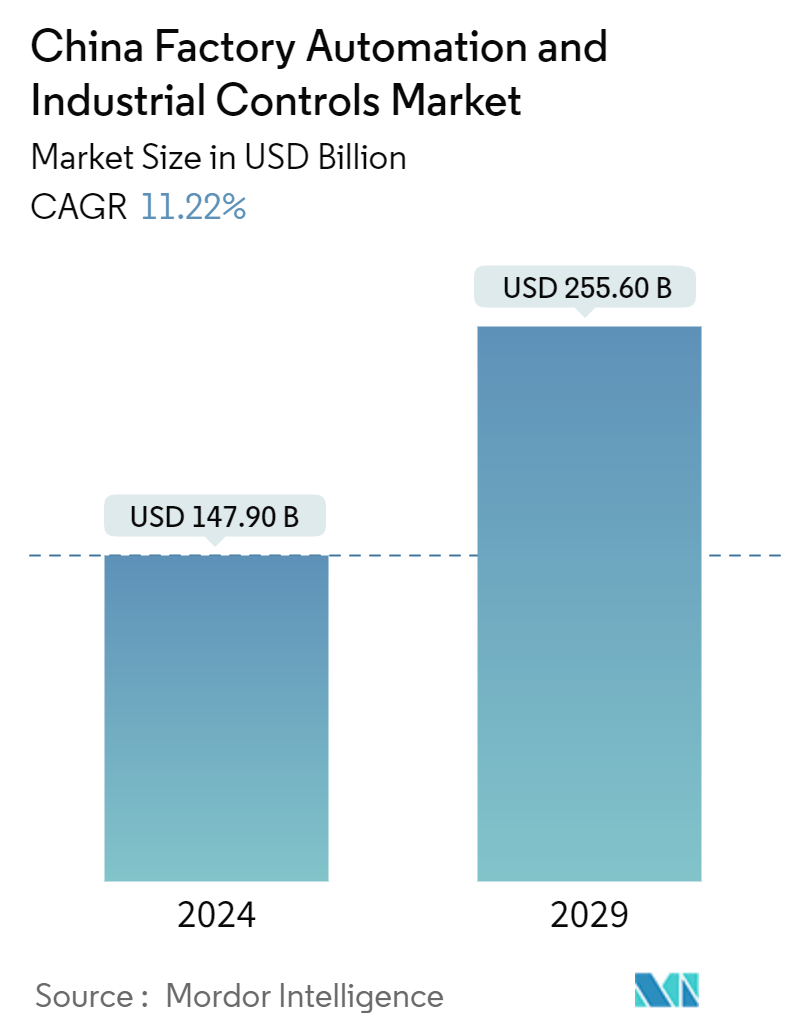
| Study Period | 2019 - 2029 |
| Base Year For Estimation | 2023 |
| Market Size (2024) | USD 147.90 Billion |
| Market Size (2029) | USD 255.60 Billion |
| CAGR (2024 - 2029) | 11.22 % |
| Market Concentration | Low |
Major Players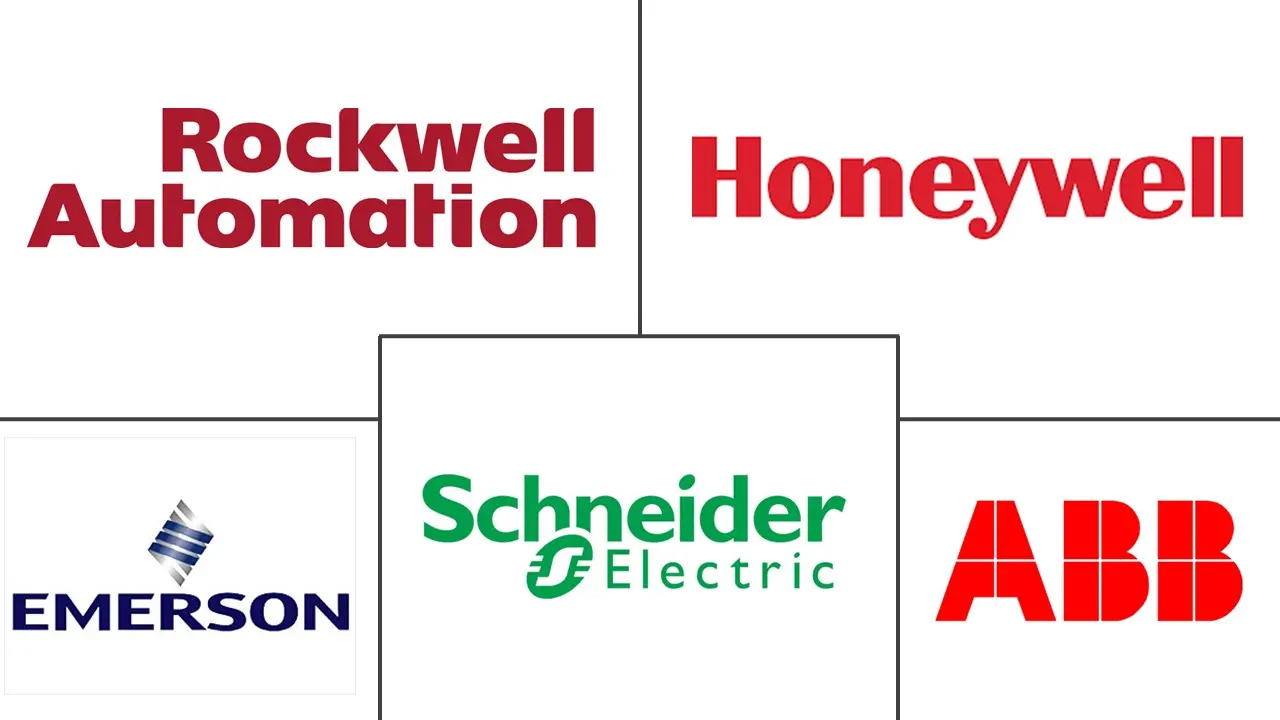
*Disclaimer: Major Players sorted in no particular order |
China Factory Automation And Industrial Controls Market Analysis
The China Factory Automation And Industrial Controls Market size is estimated at USD 147.90 billion in 2024, and is expected to reach USD 255.60 billion by 2029, growing at a CAGR of 11.22% during the forecast period (2024-2029).
- The evolution of technological advancements and innovations across various manufacturing units has encouraged the adoption of automation technologies.
- Digitization and Industry 4.0 initiatives in China have significantly stimulated the growth of automation among industries by necessitating more innovative and automated solutions, such as robotics and control systems, to improve production processes. China's economy witnessed impressive growth due to its manufacturing capabilities and the government's investments in factories, infrastructure, and machinery.
- China has led the industrial robot market, driving its way to factory automation in the region. The country is also one of the leading manufacturing countries globally in Asia-Pacific. The increase in the shipment of industrial robots in the country and the adoption of various industrial control system software across the country facilitates factory automation at scale.
- Automation in China is expected to be augmented by the uptake of intelligent manufacturing. According to the Ministry of Industry and Information Technology, the country has initiated over 100 pilot projects for intellectual manufacturing in the past few years. Also, in June 2022, Shenzhen announced the Action Plan for Cultivating and Developing Intelligent Robot Industry Clusters. In June 2023, the Beijing Municipal government announced the Beijing Robot Industry Innovation and Development Action Plan (2023-2025).
- Government incentives and targets have advanced the potential of the Chinese market to dive into factory automation. Made in China 2025 plan encourages domestic players to decrease their dependency on foreign players. The rapidly soaring labor costs and declining manufacturing labor force supply in China are also helping in the penetration of industrial robots and factory automation.
- The government's strong support in the acquisition program has helped the country move towards Industry 4.0. For instance, Siasun, a China-based industrial robot maker, is affiliated with the Chinese Academy of Sciences, which is further linked to the government.
- With the rising cost of production in China and the strengthening of the Yuan against the Dollar, investors have been looking at alternate manufacturing destinations. However, manufacturers need to focus on quality production and environment-friendly manufacturing regulations. With the growing technology, a fully automated facility takes years to adjust and evolve. Meanwhile, unfavorable or delayed initiatives on active automation adaptation have limited growth on a regional basis.
China Factory Automation And Industrial Controls Market Trends
The Distributed Control System Segment is Expected to Hold a Significant Market Share
- DCS are process-oriented platforms that depend on interconnected sensors, controllers, terminals, and actuators to act as a centralized master controller for a facility's production operations. Thus, a DCS focuses on controlling and monitoring processes and allowing facility operators to see all facility operations from one place.
- One of the significant benefits of the DCS system is that the digital communication between distributed controllers, workstations, and other computing elements follows the peer-to-peer access principle. To achieve greater precision and control in process industries, like the petrochemical, nuclear, and oil and gas industries, there is an increasing demand for controllers that offer specified process tolerance around an identified set point.
- Moreover, many requirements have driven the adoption of DCS, as these systems provide lower operational complexity, project risk, and functionalities like flexibility for agile manufacturing in highly demanding applications. The ability of DCS to integrate PLCs, turbomachinery controls, safety systems, third-party controls, and various other plant process controls for heat exchangers, feedwater heaters, and water quality further drives the adoption of DCS in the energy sector.
- The growth in electric power generation in China is developing demand for distributed control systems (DCS). According to the national power industry statistics for the 2023 report published by CEC, the total installed electricity generation capacity in China in 2023 was 2919.6 gigawatts.
- In January 2022, China announced the use of dual control systems to control energy consumption. In the future, energy consumption and intensity will be transformed into a "dual control system" for carbon emissions and power. These initiatives will accelerate the adoption of the DCS system in the major manufacturing facilities between 2024 and 2029.
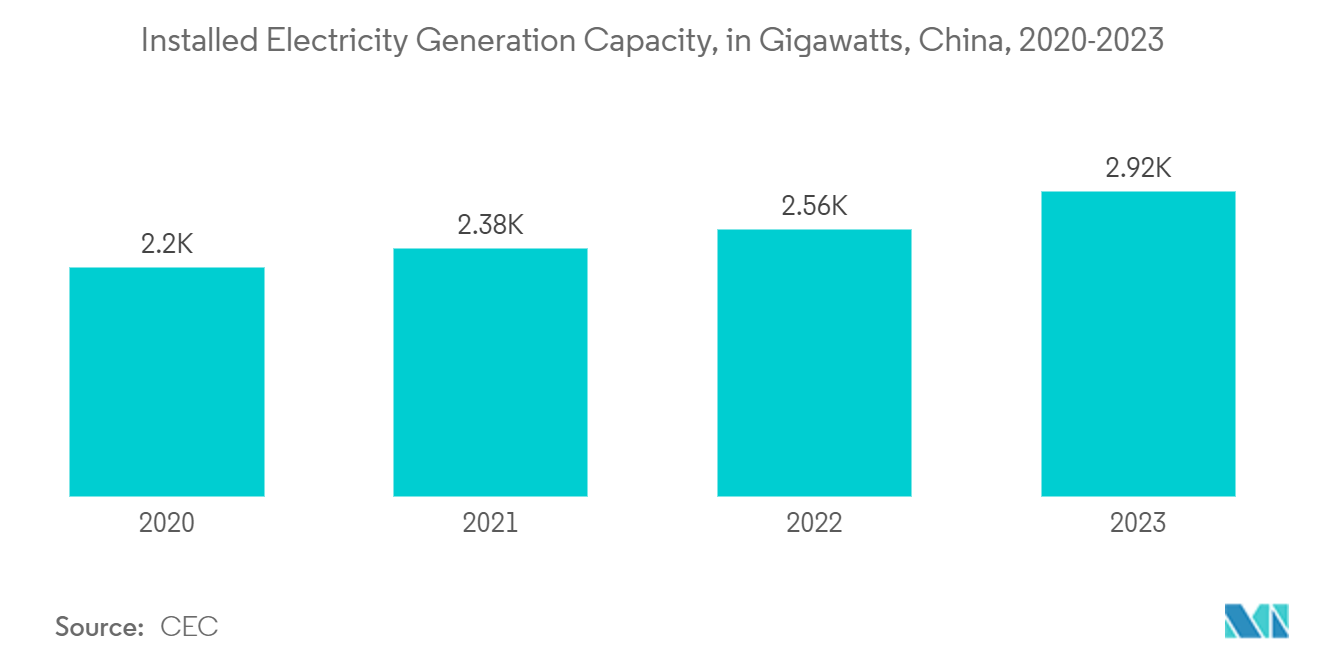
The Oil and Gas Sector is Expected to Register a Significant Growth
- The geographically dispersed oil and gas platforms require proper communication systems. Growth in solutions like PLC, SCADA, DCS, and safety automation is attributed to the enormous development of industries in China. It is also expected to create a massive demand for automation products that include DCS systems.
- In March 2023, Aramco signed definitive agreements to acquire a 10% shareholding in Shenzhen-listed Rongsheng Petrochemical Co. Ltd for CNY 24.6 billion (USD 3.6 billion); this would significantly expand its downstream presence in China. Under the strategic agreement, as part of an ongoing long-term sales arrangement with Rongsheng's subsidiary Zhejiang Petroleum and Chemical Co. Ltd, Aramco would supply this company with 480,000 barrels of Arabian crude oil daily.
- Moreover, the oil and gas industry is subject to several government regulations for safety, plant reliability, and efficiency. ICS finds applications in remote terminal units (RTU) and pumping and compression stations to ensure safety.
- The industry increasingly adopts ICS solutions to maintain safety and environmental integrity without compromising production efficiency. Automation helps integrate information and control, power, and safety solutions to meet the requirements of affordable energy and stringent government regulations.
- Moreover, owing to the high demand for automation in the oil and gas industry, Seeq expanded its support for the oil and gas industry by introducing new connectors to CygNet enterprise Supervisory Control and Data Acquisition (SCADA) Wellsite Information Transfer Markup Language (WITSML) data storage systems. This enables advanced analytics and faster data-based decision-making in the current challenging industry environment.
- Over the past few years, oil and gas companies have invested heavily in cybersecurity technologies, such as incident response solutions and software capable of collecting logs in ICS environments to enhance visibility and segmenting networks, prevent lateral movement, and eliminate imminent threats.
- The industry increasingly adopts ICS solutions to maintain safety and environmental integrity without compromising production efficiency. Automation helps integrate information and control, power, and safety solutions to meet the requirements of affordable energy and stringent government regulations.
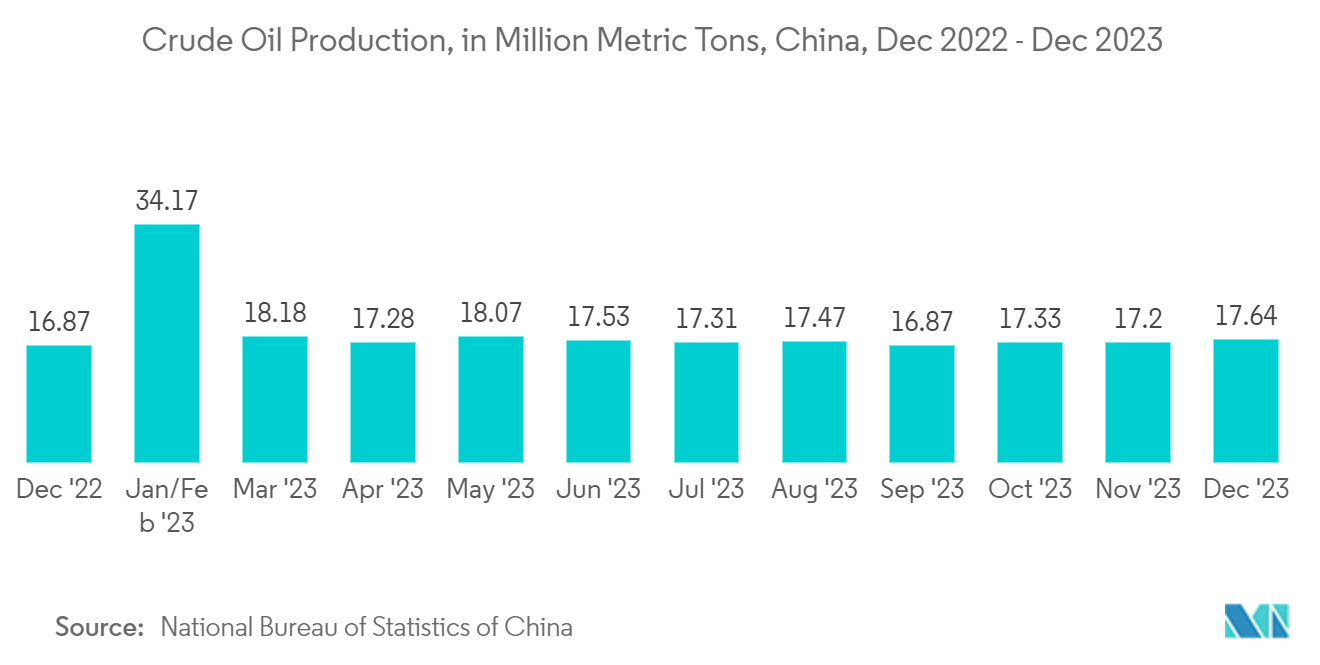
China Factory Automation And Industrial Controls Industry Overview
The Chinese factory automation and industrial controls market is highly fragmented, with the presence of several prominent companies. Companies continuously invest in strategic partnerships and product developments to gain market share. Some of the recent developments in the market are:
- March 2024 - Rockwell Automation announced that it is collaborating with NVIDIA to accelerate the next-generation industrial architecture. To make it easier for automation customers to digitalize industrial processes, Rockwell plans to evolve the industry by building a future factory.
- February 2024 - ABB announced that it plans to leverage this integration of AI with robotics in sectors such as automotive, consumer goods, education, and emerging areas like healthcare, retail, and new energy. This strategic move aims to create additional value for customers by introducing new levels of autonomy in robotic applications across China.
China Factory Automation And Industrial Controls Market Leaders
-
Schneider Electric SE
-
Honeywell International Inc.
-
ABB Ltd.
-
Rockwell Automation, Inc.
-
Emerson Electric Company
*Disclaimer: Major Players sorted in no particular order
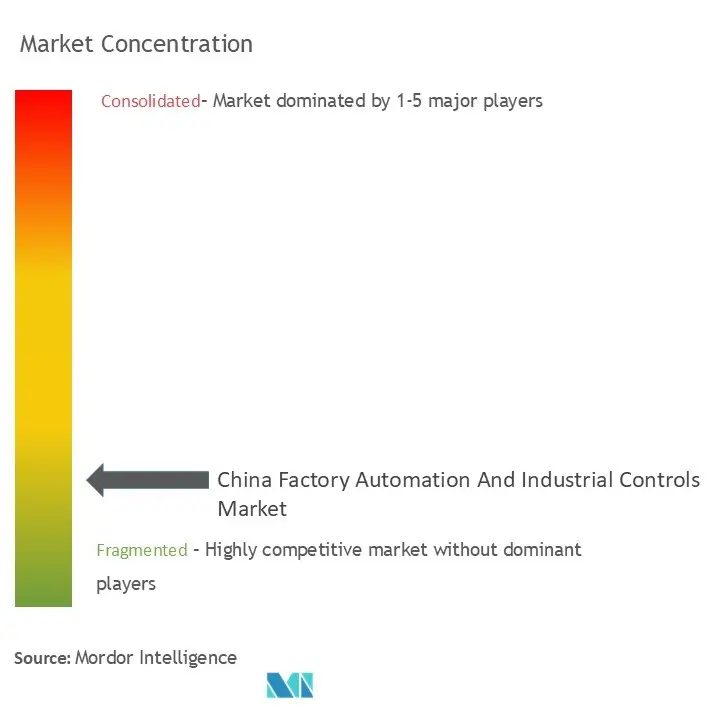
China Factory Automation And Industrial Controls Market News
- April 2024 - Valmet announced the launch of the next-generation distributed control system (DCS), the Valmet DNAe. It provides a solid platform for moving toward more digitalized, autonomous operations, helping customers thrive in the changing business environment. The system provides a familiar user interface for controls, analytics, configuration, and maintenance.
- November 2023 - Nio, one of China’s top three builders of premium EVs, announced that it aims to reduce its workforce by a third by 2027 as it rapidly replaces them with robots.
China Factory Automation And Industrial Controls Market Report - Table of Contents
1. INTRODUCTION
- 1.1 Study Assumptions and Market Definition
- 1.2 Scope of the Study
2. RESEARCH METHODOLOGY
3. EXECUTIVE SUMMARY
4. MARKET INSIGHTS
- 4.1 Market Overview
- 4.2 Industry Value Chain Analysis
-
4.3 Industry Attractiveness - Porter's Five Forces Analysis
- 4.3.1 Bargaining Power of Suppliers
- 4.3.2 Bargaining Power of Consumers
- 4.3.3 Threat of New Entrants
- 4.3.4 Threat of Substitute Products
- 4.3.5 Intensity of Competitive Rivalry
5. MARKET DYNAMICS
-
5.1 Market Drivers
- 5.1.1 Growing Prominence of Automation Technologies Due to Declining Workforce
-
5.2 Market Challenges
- 5.2.1 Industry Policies and Regulations
6. MARKET SEGMENTATION
-
6.1 By Type
- 6.1.1 Industrial Control Systems
- 6.1.1.1 Distributed Control System (DCS)
- 6.1.1.2 PLC (Programmable Logic Controller)
- 6.1.1.3 Supervisory Control and Data Acquisition (SCADA)
- 6.1.1.4 Product Lifecycle Management (PLM)
- 6.1.1.5 Human Machine Interface (HMI)
- 6.1.1.6 Manufacturing Execution System (MES)
- 6.1.1.7 Enterprise Resource Planning (ERP)
- 6.1.1.8 Other Industrial Control Systems
- 6.1.2 Field Devices
- 6.1.2.1 Sensors and Transmitters
- 6.1.2.2 Electric Motors and Drives
- 6.1.2.3 Industrial Robotics
- 6.1.2.4 Machine Vision Systems
- 6.1.2.5 Other Field Devices
-
6.2 By End-user Industry
- 6.2.1 Oil and Gas
- 6.2.2 Chemical and Petrochemical
- 6.2.3 Power and Utilities
- 6.2.4 Automotive and Transportation
- 6.2.5 Pharmaceuticals
- 6.2.6 Food and Beverage
- 6.2.7 Other End-user Industries
7. COMPETITIVE LANDSCAPE
-
7.1 Company Profiles*
- 7.1.1 General Electric Company
- 7.1.2 Schneider Electric SE
- 7.1.3 Rockwell Automation Inc.
- 7.1.4 Honeywell International Inc.
- 7.1.5 Emerson Electric Company
- 7.1.6 ABB Ltd
- 7.1.7 Mitsubishi Electric Corporation
- 7.1.8 Siemens AG
- 7.1.9 Omron Corporation
- 7.1.10 Yokogawa Electric Corporation
8. INVESTMENT ANALYSIS
9. FUTURE OF THE MARKET
** Subject To AvailablityChina Factory Automation And Industrial Controls Industry Segmentation
Factory automation and control (A&C) solutions, which require sensors, instruments, computers, and data processing applications, cover the automation of an entire production facility through the design and construction of a fully integrated and intelligent control system. Industrial automation refers to the automated process of manufacturing, quality control, and material handling. Industrial automation solutions are intended to reduce companies' reliance on unreliable and error-prone manual processes in manufacturing, replacing them with command response activities carried out by automated equipment and logical programming. Programmable logic controllers (PLCs), stand-alone I/O modules, and computers are industrial-process general-purpose controllers.
The Chinese factory automation and industrial controls market is segmented by product type (industrial control systems (distributed control system, programmable logic controller, supervisory control and data acquisition, product lifecycle management, human-machine interface, manufacturing execution system, enterprise resource planning, and other industrial control systems), field devices (machine vision systems, sensors, and transmitters, electric motors and drives, industrial robotics, and other field devices)), by end-user industry (oil and gas, chemical and petrochemical, power and utilities, automotive and transportation, pharmaceuticals, and food and beverage). The market sizes and forecasts are provided in terms of value in USD for all the above segments.
| By Type | Industrial Control Systems | Distributed Control System (DCS) |
| PLC (Programmable Logic Controller) | ||
| Supervisory Control and Data Acquisition (SCADA) | ||
| Product Lifecycle Management (PLM) | ||
| Human Machine Interface (HMI) | ||
| Manufacturing Execution System (MES) | ||
| Enterprise Resource Planning (ERP) | ||
| Other Industrial Control Systems | ||
| By Type | Field Devices | Sensors and Transmitters |
| Electric Motors and Drives | ||
| Industrial Robotics | ||
| Machine Vision Systems | ||
| Other Field Devices | ||
| By End-user Industry | Oil and Gas | |
| Chemical and Petrochemical | ||
| Power and Utilities | ||
| Automotive and Transportation | ||
| Pharmaceuticals | ||
| Food and Beverage | ||
| Other End-user Industries |
China Factory Automation And Industrial Controls Market Research FAQs
How big is the China Factory Automation And Industrial Controls Market?
The China Factory Automation And Industrial Controls Market size is expected to reach USD 147.90 billion in 2024 and grow at a CAGR of 11.22% to reach USD 255.60 billion by 2029.
What is the current China Factory Automation And Industrial Controls Market size?
In 2024, the China Factory Automation And Industrial Controls Market size is expected to reach USD 147.90 billion.
Who are the key players in China Factory Automation And Industrial Controls Market?
Schneider Electric SE, Honeywell International Inc., ABB Ltd., Rockwell Automation, Inc. and Emerson Electric Company are the major companies operating in the China Factory Automation And Industrial Controls Market.
What years does this China Factory Automation And Industrial Controls Market cover, and what was the market size in 2023?
In 2023, the China Factory Automation And Industrial Controls Market size was estimated at USD 131.31 billion. The report covers the China Factory Automation And Industrial Controls Market historical market size for years: 2019, 2020, 2021, 2022 and 2023. The report also forecasts the China Factory Automation And Industrial Controls Market size for years: 2024, 2025, 2026, 2027, 2028 and 2029.
China Factory Automation And Industrial Controls Industry Report
Statistics for the 2024 China Factory Automation & Industrial Controls market share, size and revenue growth rate, created by Mordor Intelligence™ Industry Reports. China Factory Automation & Industrial Controls analysis includes a market forecast outlook to 2029 and historical overview. Get a sample of this industry analysis as a free report PDF download.



